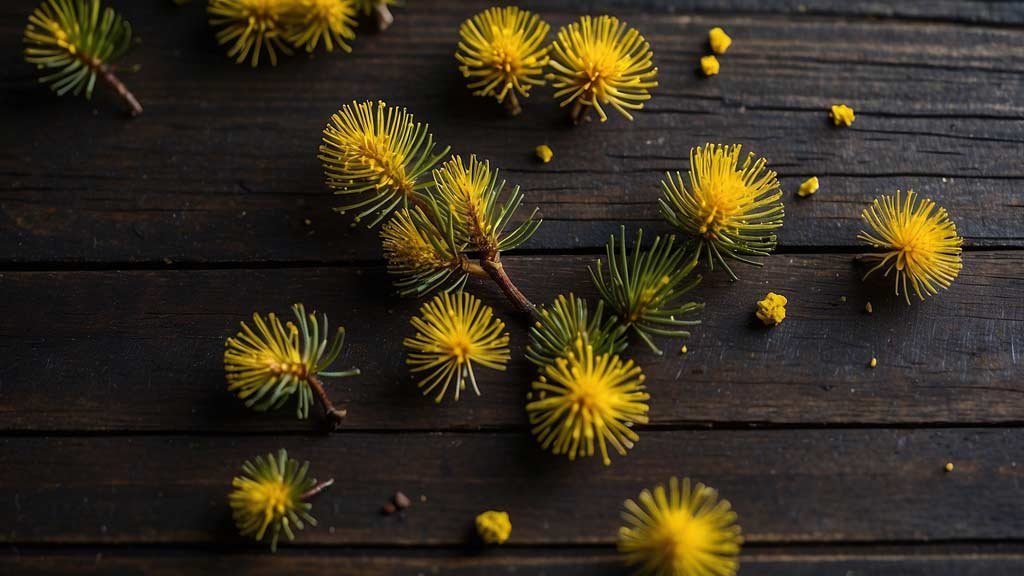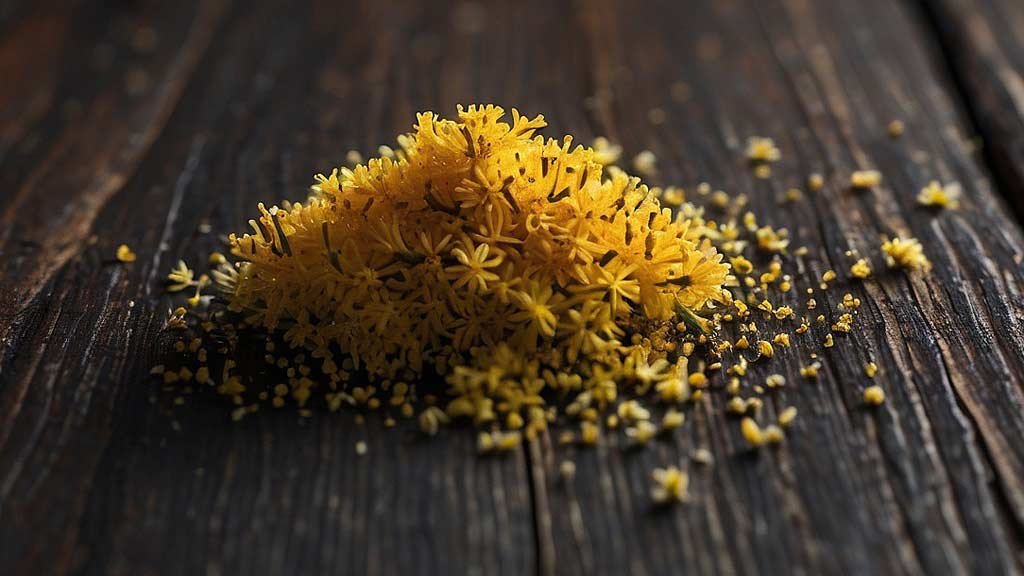The Quiet Strength of Pine Pollen
Walk past a pine forest in the spring and you might notice the air carrying a faint golden haze. That’s pine pollen—tiny granules of concentrated life force drifting through the wind, dusting cars, windowsills, and sometimes even your eyelashes. Most people just sneeze. But herbalists, traditional healers, and modern wellness seekers have looked at that same pollen and seen something different: a nutrient-dense superfood with the power to support energy, vitality, and hormone balance.
Pine pollen isn’t new. Ancient Chinese medical texts praised it as a tonic for longevity and resilience. Today, it’s gaining traction as both a food and a supplement, especially among people interested in natural ways to boost testosterone, restore stamina, or simply feel less worn down by daily stress.
Is it hype? Some. Is there substance behind the claims? Quite a bit.
Table of Contents
What Exactly Is Pine Pollen?
Pine pollen is the male spore of pine trees, most often from species like Pinus massoniana, Pinus sylvestris, or Pinus tabuliformis. Each grain carries the genetic blueprint needed for reproduction—no surprise it’s packed with nutrients.
If you scoop up fresh pollen, you’ll find it’s a fine, yellow powder that tastes slightly nutty, earthy, and faintly bitter. Some people stir it into smoothies. Others prefer tinctures, since the cell wall of pollen can be tough to digest unless it’s cracked or extracted.
Nutritionally, pine pollen contains:
- Amino acids (including all nine essential ones)
- Vitamins (notably B-complex, vitamin D, and E)
- Minerals (zinc, selenium, magnesium)
- Flavonoids and antioxidants
- Plant sterols and phytoandrogens
It’s a cocktail of raw nutrition, but the compounds that draw the most attention are those linked to hormone health.
Pine Pollen and Hormone Support
Pine pollen is unique among plant foods because it contains substances that mimic androgens—compounds similar to testosterone and DHEA. While plants don’t produce testosterone in the same way humans do, pine pollen has phytosterols and androgens that may influence hormone pathways.
Men often turn to pine pollen as a natural way to:
- Support testosterone levels
- Improve energy and stamina
- Enhance recovery after exercise
- Boost libido
There’s anecdotal evidence of men reporting increased vitality after taking it, especially those past their 40s when testosterone naturally declines. Traditional Chinese Medicine has long used it for balancing yin and yang, which in modern terms often translates to restoring depleted energy and sexual health.
But it’s not just for men. Women also use pine pollen for hormonal balance, particularly during perimenopause and menopause, where it may ease fatigue, mood swings, and low libido. Its mix of minerals and antioxidants can help counter oxidative stress that contributes to hormonal imbalances in the first place.
Does this mean it works like hormone replacement therapy? No. The body doesn’t absorb plant androgens in the same way as pharmaceutical hormones. Think of pine pollen less as a replacement and more as a gentle nudge—encouraging the body to regulate itself more smoothly.
Energy, Vitality, and the Everyday Boost
Ever noticed how some days coffee just doesn’t cut it? Pine pollen is often described as a “tonic,” meaning it nourishes the whole system rather than forcing an immediate jolt. That’s one reason people take it daily, not just when they’re dragging.
It supports energy in a few ways:
- Nutrient density: The amino acids, B-vitamins, and minerals help cellular energy production.
- Adaptogenic properties: Though not technically an adaptogen like ginseng, pine pollen behaves similarly, helping the body adapt to stress.
- Endocrine support: Balanced hormones often mean steadier energy and better recovery.
I’ve heard folks compare it to a subtle reset button. Not the jittery energy spike of caffeine, but a steady hum of vitality that builds over weeks. One friend described it as “the difference between dragging myself through the day and feeling like I’m actually in my own skin again.”
Antioxidant and Anti-Inflammatory Effects
Like many plant foods, pine pollen contains flavonoids and polyphenols. These compounds have antioxidant properties, meaning they mop up free radicals before they damage cells.
Chronic inflammation is at the root of so many health issues—fatigue, joint pain, heart disease, even accelerated aging. Pine pollen seems to offer a buffer here, supporting the body’s natural defenses. Studies on animals have shown reductions in oxidative stress markers when given pine pollen extracts. While human trials are still limited, the traditional and nutritional case is compelling.
Ways to Use Pine Pollen
The form matters. If you’re curious, here’s how people typically take it:
- Raw powder: Sprinkle into smoothies, oatmeal, or tea. Look for “cell-wall cracked” for better absorption.
- Tincture: Alcohol extracts that may deliver more of the active compounds directly into the bloodstream.
- Capsules: Convenient, though you lose the sensory connection of tasting it.
- Topical salves: Some use pine pollen mixed into balms for skin health and wound healing.
Doses vary, but most people start small—half a teaspoon of powder or a dropper of tincture—before increasing.

Taste, Texture, and Experience
Let’s be honest: pine pollen isn’t candy. The taste is earthy, almost resinous, with a whisper of pine forest after rain. In powder form, it clings to your tongue like chalk. Some folks love the wildness of it; others hide it in smoothies.
But something is grounding about consuming it in its raw form. It feels connected—like taking in a bit of the forest itself. And maybe that’s part of the medicine too.
Safety and Precautions
Pine pollen is generally considered safe, especially as a food. But there are a few points worth noting:
- If you have pine allergies, approach cautiously; pollen can trigger reactions.
- Since it may influence hormones, people with hormone-sensitive conditions (like certain cancers) should consult a professional before use.
- Pregnant or breastfeeding women should avoid it unless guided by a qualified practitioner.
Also, quality matters. Pollen can easily collect environmental toxins. Always source from clean, wild areas or trusted suppliers who test for heavy metals.
Pine Pollen in Traditional Medicine
Traditional Chinese Medicine has long considered pine pollen a “shen tonic”—something that strengthens spirit as well as body. It was used to increase stamina, support digestion, and encourage longevity. Some records even mention it being used to treat fatigue in scholars who burned out from too much study, which feels oddly relatable today.
There’s something about that continuity across centuries that lends weight to modern enthusiasm. Science may still be catching up, but people have leaned on pine pollen for over a thousand years.
The Bigger Picture
Pine pollen is not a magic bullet. It won’t replace good sleep, healthy food, or stress management. But as a supportive ally, it can make a noticeable difference—especially for those looking to reclaim energy and restore balance to their hormones.
It’s easy to dismiss natural remedies as fads, but sometimes, they’re simply rediscoveries. Pine pollen has drifted through the air for millennia. We’re only now remembering to pay attention.
Article Sources
At AncientHerbsWisdom, our content relies on reputable sources, including peer-reviewed studies, to substantiate the information presented in our articles. Our primary objective is to ensure our content is thoroughly fact-checked, maintaining a commitment to accuracy, reliability, and trustworthiness.
- Li, Y., Zhang, J., Wang, Y., & Wang, C. (2012). Immunoregulatory and antioxidant effects of pine pollen polysaccharides in mice. International Journal of Biological Macromolecules, 51(5), 600–604. https://doi.org/10.1016/j.ijbiomac.2012.06.008
- Liu, J., Xu, G., Shi, X., & Zhang, Y. (2019). Protective effects of pine pollen against oxidative stress in mice induced by D-galactose. Evidence-Based Complementary and Alternative Medicine, 2019, 1–8. https://doi.org/10.1155/2019/3062639
- National Center for Complementary and Integrative Health. (2020). Antioxidants: In depth. NCCIH. Retrieved from https://www.nccih.nih.gov/health/antioxidants-in-depth
- Park, J. H., Lee, S. H., & Kim, H. J. (2016). Nutritional composition and bioactive compounds of pine pollen. Journal of the Korean Society of Food Science and Nutrition, 45(3), 347–353. https://doi.org/10.3746/jkfn.2016.45.3.347
- Zhang, W., Zhao, Y., Zhang, J., & Huang, X. (2011). Study on androgenic compounds in Pinus massoniana pollen. Journal of Medicinal Plants Research, 5(15), 3530–3535. https://academicjournals.org/journal/JMPR/article-full-text-pdf/74D0C762946

